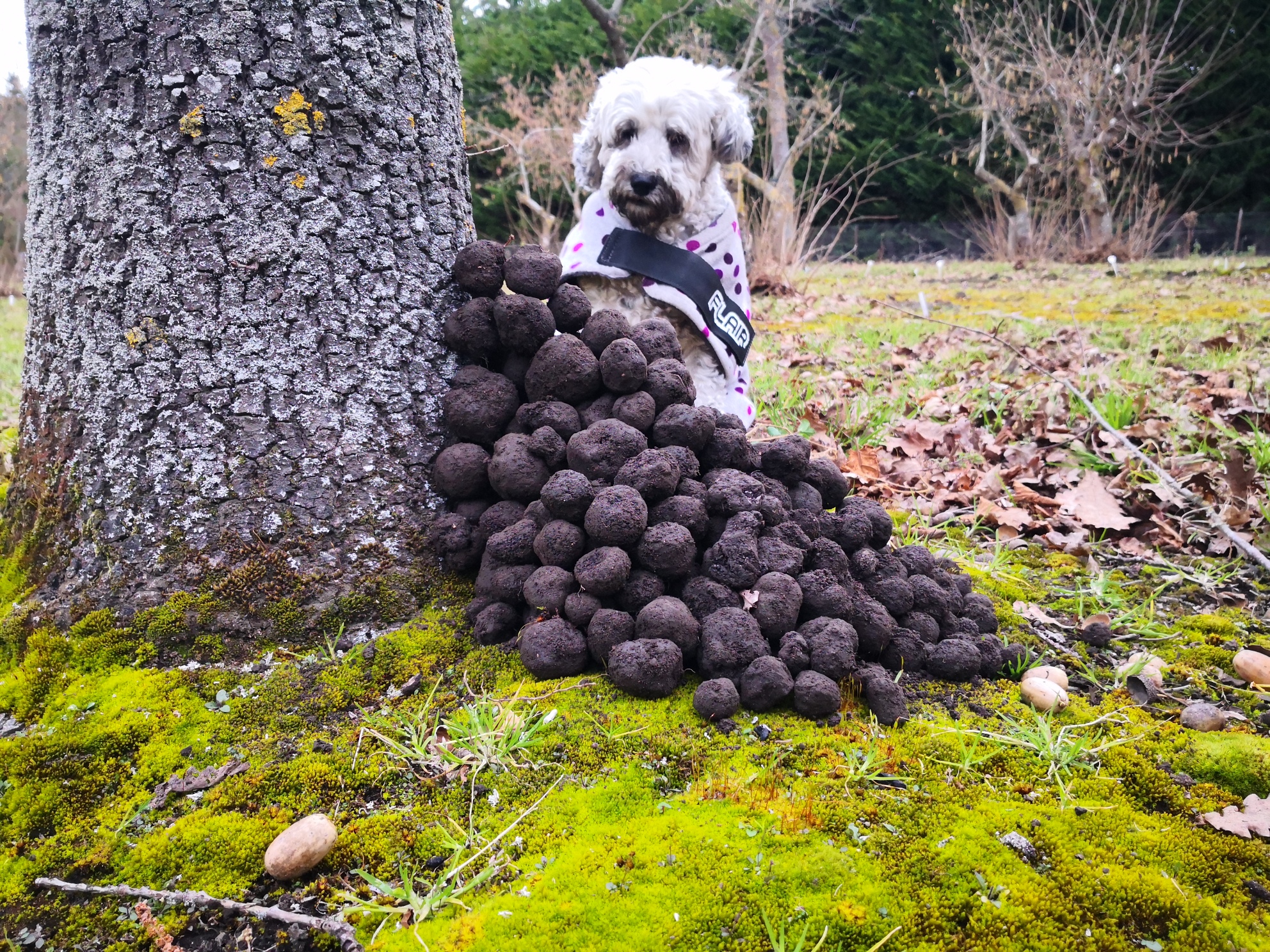Growers of the
"Périgord Black Truffle"


|
Growers of the "Périgord Black Truffle"
|
Storing Truffles
Truffles emit their aroma continually until it is totally exhausted; the rate
accelerating on exposure to air. Either the strong pervasive truffle aroma
vaporises and disappears or it permeates any other absorbent items kept in close
proximity. At the same time the truffles will also dehydrate. Considerable care
is thus required with their storage. Following thorough cleaning to remove any adhering soil, truffles need to be
kept in their own sealed containers. Any other suitable foodstuff, intended to
be flavoured by the truffles, can be stored in the same containers. In
restaurants where a number of truffles are constantly in use, these are kept in
glass jars or on glass covered metal trays or wooden boards. Exposed truffles on
display in shops and markets are sold or used the same day. For short-term storage, no special measures are necessary but for longer
storage periods, truffles need to be preserved by certain procedures. Preserving Truffles
The truffle peridium (skin) forms a natural protection for the truffle gleba
(flesh), and removing the skin and exposing the flesh will accelerate the
truffle's deterioration. All truffles for culinary use should be thoroughly
cleaned but kept intact and unpeeled until ready for use. If truffles are not
going to be used immediately, their storage life can be extended to keep them
fresh and preserve their flavour qualities by storing them short term in a
fridge, and longer term in a freezer. Chilling Truffles
Truffles can be refrigerated and kept fresh for up to two weeks. After
thorough cleaning and drying, they are loosely placed inside a tightly closed,
cry, airtight container, such as a mason glass jar, to exclude any moisture. The
container is placed in the coldest part of the fridge (either next to the
freezer compartment or, because cold air sinks, on the bottom shelf), with an
optimum temperature of 2-4°C and relative humidity of 80-85%. Frost-free
fridges are more efficient as they circulate the air to maintain even internal
temperature distribution. Freezing Truffles
For
longer storage, truffles can be frozen without loss of aroma for up to six
months. After proper cleaning, the truffles are placed loosely in freezer-proof,
airtight or vacuum-sealed glass containers and stored in the freezer. Commercial
ventures are particularly careful to avoid any moisture condensing on the
truffles. Individually
wrapping the truffles tightly in metal foil before placing in the container
can prevent frost from the internal moisture forming on the surface. Though
freezing will cause the truffles to loose some of their texture, it also
prevents dehydration and will thus allow the truffles to retain most of their
aroma. Frozen truffles are not thawed before using; the winter white, winter black,
scorzone black and smooth black are shaved while still frozen, and the others
cooked straight from the freezer, as they become spongy when thawed. Once any
truffle is defrosted, it cannot be re-frozen without deterioration in quality,
so it is used as early as possible. Truffles in Rice
The best way of storing truffles to preserve their aroma is to emulate their
natural underground habitat, soil, and completely cover them in a suitable
substrate. Clean fine sand would do, but edible foodstuff is even better. The
choice item to preserve truffles is uncooked rice grains. Truffles need their
moisture to retain their aroma and should not be allowed to dry out. The rice
grains will protect the natural moisture in the truffles, while preventing them
from getting damp from excess moisture that could start decay. During commercial transport, truffles are preserved after thorough cleaning,
layered, spaced apart and completely covered in rice grains, in sealed metal
trays or wooden crates and stored in refrigerated trucks. On delivery to
restaurants, the containers are transferred to a refrigerated room, where they
can be removed and used gradually. For home storage, truffles are kept in an airtight, sealed stainless steel
container large enough for all the truffles and the rice. A thick layer of rice
is poured into the container and the truffles after cleaning are set a few
centimetres apart from one another, and then covered up abundantly with more
rice. The sealed container of cleaned truffles and rice is stored in a cool dry
dark place, ideally at about 4°C. (3-5°C) in a refrigerator, when they will
keep well in this near sterile environment for about three weeks. Truffles stored in rice will not keep indefinitely; however, with prolonged
storage, the truffles will not decay but will gradually dry out and the aroma
will fade.
Stored together in sealed containers, the rice grains will be strongly
scented by the intense aroma of the truffles but, while some of the truffle
scent will be transferred to the rice grains, much of it will be intact. As the
truffles are used, the truffle scented rice can be cooked as a separate dish.
Any variety of rice is suitable for preserving truffles. Various local rice
varieties are preferred in different countries: arborio rice in Truffle Peelings and Truffle Paste
Such is the intensity of the truffle aroma, every scrap of it can be used,
and it is fortunate indeed considering the effort involved in locating it and
the cost. Both the peelings and little pieces too small for regular use can be
made into a paste. Spoilt Truffles
Fresh truffles should not be wrapped in plastic cling film or kept in plastic
bags, as they then tend to become slimy and will rot very quickly. Even some
haute cuisine chefs fail to preserve fresh truffles properly. Indeed many of
them recommend wrapping truffles individually in absorbent (paper towels or
similar) and storing them in plastic containers, changing the paper daily to
prevent any build-up of moisture. This recommendation avoids condensation, but
will cause the truffles to transfer their precious aroma to the absorbent paper,
to be discarded with the paper each time it is changed, while the truffle aroma
progressively diminishes. Some chefs even suggest not removing the traces of
soil on the truffles before wrapping, thus trapping the dirt in with the
storage. When truffles begin to soften slightly, they have reached their highest
ripening point and should be used immediately; after that they will start to
deteriorate. If they have become mushy, show signs of sweating and releasing
moisture, it is too late and they can no longer be consumed. Any whiff of
ammonia indicates that the truffles are decomposing; they should be removed and
discarded. To avoid such waste, be conscious of the state of the truffles when acquired,
and check them everyday for any changes in quality. |
|